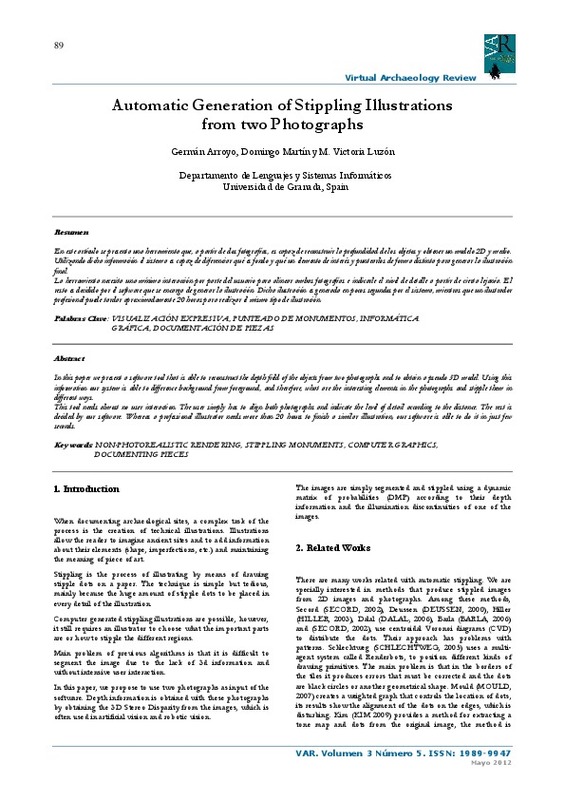JavaScript is disabled for your browser. Some features of this site may not work without it.
Buscar en RiuNet
Listar
Mi cuenta
Estadísticas
Ayuda RiuNet
Admin. UPV
Automatic Generation of Stippling Illustrations from two Photographs
Mostrar el registro sencillo del ítem
Ficheros en el ítem
| dc.contributor.author | Arroyo, Germán
|
es_ES |
| dc.contributor.author | Martín, Domingo
|
es_ES |
| dc.contributor.author | Luzón, María Victoria
|
es_ES |
| dc.date.accessioned | 2020-03-24T08:11:05Z | |
| dc.date.available | 2020-03-24T08:11:05Z | |
| dc.date.issued | 2012-05-13 | |
| dc.identifier.uri | http://hdl.handle.net/10251/139260 | |
| dc.description.abstract | [EN] In this paper we present a software tool that is able to reconstruct the depth field of the objects from two photographs and to obtain a pseudo 3D model. Using this information our system is able to difference background from foreground, and therefore, what are the interesting elements in the photographs and stipple them in different ways.This tool needs almost no user interaction. The user simply has to align both photographs and indicate the level of detail according to the distance. The rest is decided by our software. Whereas a professional illustrator needs more than 20 hours to finish a similar illustration, our software is able to do it in just few seconds. | es_ES |
| dc.description.abstract | [ES] En este artículo se presenta una herramienta que, a partir de dos fotografías, es capaz de reconstruir la profundidad de los objetos y obtener un modelo 2D y medio. Utilizando dicha información el sistema es capaz de diferenciar qué es fondo y qué un elemento de interés y puntearlos de forma distinta para generar la ilustración final.La herramienta necesita una mínima interacción por parte del usuario para alinear ambas fotografías e indicarle el nivel de detalle a partir de cierta lejanía. El resto es decidido por el software que se encarga de generar la ilustración. Dicha ilustración es generada en pocos segundos por el sistema, mientras que un ilustrador profesional puede tardar aproximadamente 20 horas para realizar el mismo tipo de ilustración. | es_ES |
| dc.description.sponsorship | Thanks to Consejería de Innovación y Empresa of the Junta de Andalucía that has partially funded this article throw the project of excelency PE09-TIC-5276. | es_ES |
| dc.language | Inglés | es_ES |
| dc.publisher | Universitat Politècnica de València | es_ES |
| dc.relation.ispartof | Virtual Archaeology Review | es_ES |
| dc.rights | Reconocimiento - No comercial - Sin obra derivada (by-nc-nd) | es_ES |
| dc.subject | Non-Photorealistic rendering | es_ES |
| dc.subject | Stippling monuments | es_ES |
| dc.subject | Computer graphics | es_ES |
| dc.subject | Documenting pieces | es_ES |
| dc.subject | Visualización expresiva | es_ES |
| dc.subject | Punteado de monumentos | es_ES |
| dc.subject | Informática gráfica | es_ES |
| dc.subject | Documentación de piezas | es_ES |
| dc.title | Automatic Generation of Stippling Illustrations from two Photographs | es_ES |
| dc.type | Artículo | es_ES |
| dc.identifier.doi | 10.4995/var.2012.4530 | |
| dc.relation.projectID | info:eu-repo/grantAgreement/Junta de Andalucía//PE09-TIC-5276/ | es_ES |
| dc.rights.accessRights | Abierto | es_ES |
| dc.description.bibliographicCitation | Arroyo, G.; Martín, D.; Luzón, MV. (2012). Automatic Generation of Stippling Illustrations from two Photographs. Virtual Archaeology Review. 3(5):89-92. https://doi.org/10.4995/var.2012.4530 | es_ES |
| dc.description.accrualMethod | OJS | es_ES |
| dc.relation.publisherversion | https://doi.org/10.4995/var.2012.4530 | es_ES |
| dc.description.upvformatpinicio | 89 | es_ES |
| dc.description.upvformatpfin | 92 | es_ES |
| dc.type.version | info:eu-repo/semantics/publishedVersion | es_ES |
| dc.description.volume | 3 | es_ES |
| dc.description.issue | 5 | es_ES |
| dc.identifier.eissn | 1989-9947 | |
| dc.relation.pasarela | OJS\4530 | es_ES |
| dc.contributor.funder | Junta de Andalucía | es_ES |
| dc.description.references | BARLA, P. et al. (2006): "Interactive hatching and stippling by example". INRIA. | es_ES |
| dc.description.references | DALAL, K. et al. (2006): "A Spectral Approach to NPR Packing". In Proc. of NPAR, ACM, New York, pp. 71-78. http://dx.doi.org/10.1145/1124728.1124741 | es_ES |
| dc.description.references | DEUSSEN O. et al. (2000): "Floating points: A method for computing stipple drawings". Computer Graphics Forum 19, pp. 40-51. http://dx.doi.org/10.1111/1467-8659.00396 | es_ES |
| dc.description.references | HILLER, S. et al. (2003): "Beyond Stippling - Methods for Distributing Objects on the Plane". Computer Graphics Forum 22, 3, September, pp. 515-522. http://dx.doi.org/10.1111/1467-8659.00699 | es_ES |
| dc.description.references | ISENBERG, T. et al. (2005): "Breaking the Pixel Barrier". In Proc. of Cae, Eurographics Association, Aire-la-Ville, Switzerland, pp. 41-48. | es_ES |
| dc.description.references | KIM, S. et al. (2009): "Stippling By Example". In Proc. of NPAR, ACM, New York, pp. 41-50. http://dx.doi.org/10.1145/1572614.1572622 | es_ES |
| dc.description.references | MACIEJEWSKI R. et al. (2008): "Measuring Stipple Aesthetics in Hand-Drawn and Computer-Generated Images", IEEE Computer Graphics and Applications, pp. 62-74. http://dx.doi.org/10.1109/MCG.2008.35 | es_ES |
| dc.description.references | MOULD D. (2007): "Stipple placement using distance in a weighted graph". In Proc. of Computational Aesthetics in Graphics, no. 3. p. unknown. | es_ES |
| dc.description.references | SCHLECHTWEG S. et al. (2005): "Renderbots: Multi agent systems for direct image generation" Computer Graphics Forum 24, pp 283-290. http://dx.doi.org/10.1111/j.1467-8659.2005.00838.x | es_ES |
| dc.description.references | SECORD A. et al. (2002): "Fast primitive distribution for illustration". In Thirteenth Eurographics Workshop on Rendering, pp. 215-226. | es_ES |
| dc.description.references | SECORD, A. (2002): "Weighted voronoi stippling". In Proc. of NPAR, ACM Press, pp. 37-43. http://dx.doi.org/10.1145/508530.508537 | es_ES |








